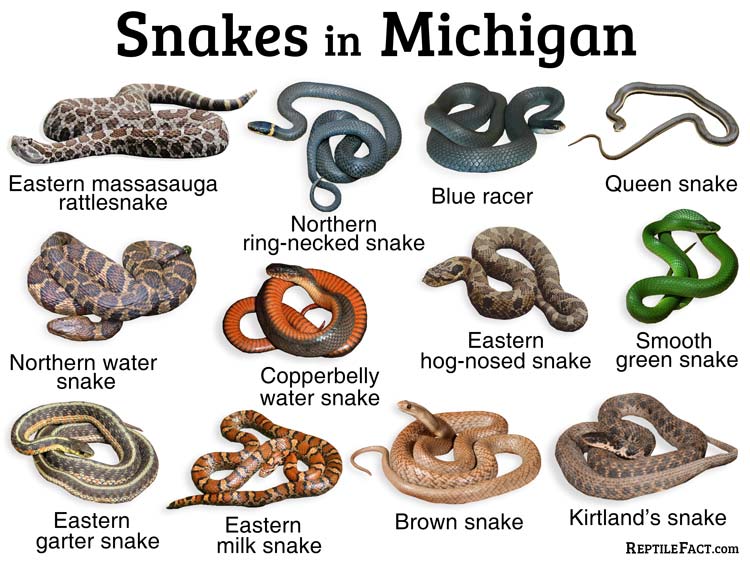Common Types of Snakes Found in Michigan
The US state of Michigan is home to 19 snake species, out of which only one is poisonous ― the Eastern massasauga rattlesnake. So, you basically need to correctly identify this one to stay out of danger. People often end up killing other, non-venomous snakes after mistaking them for a rattlesnake.
Most of the other snakes found here are rather small, so it is often tricky to differentiate between species. Here is a list of all the snakes found here so you can possibly identify the next snake you see.
Poisonous/Non-Poisonous Snakes in Michigan |
||
Poisonous or Venomous Species |
||
| 1. Eastern massasauga rattlesnake (Sistrurus catenatus catenatus) | ||
Non-venomous Snakes Found in Michigan |
||
| 1. Northern ring-necked snake (Diadophis punctatus edwardsii) | 2. Western fox snake (Pantherophis vulpinus) | 3. Eastern fox snake (Pantherophis gloydi) |
| 4. Gray rat snake (Pantherophis spiloides) | 5. Blue racer (Coluber constrictor foxii) | 6. Queen snake (Regina septemvittata) |
| 7. Kirtland’s snake (Clonophis kirtlandii) | 8. Eastern garter snake (Thamnophis sirtalis sirtalis) | 9. Brown snake (Storeria dekayi) |
| 10. Butler’s garter snake (Thamnophis butleri) | 11. Eastern milk snake (Lampropeltis triangulum triangulum) | 12. Smooth green snake (Liochlorophis vernalis) |
| 13. Northern water snake (Nerodia sipedon) | 14. Eastern hognose snake (Heterodon platirhinos) | 15. Black rat snake (Pantherophis obsoletus) |
| 16. Northern Red-bellied snake (Storeria occipitomaculata occipitomaculata) | 17. Copperbelly water snake (Nerodia erythrogaster neglecta) | 18. Northern ribbon snake (Thamnophis sauritus septentrionalis) |
By Habitat |
||
Michigan Water Snake Types |
||
| 1. Copperbelly water snake (Nerodia erythrogaster neglecta) | 2. Northern water snake (Nerodia sipedon) | |
| Other snakes found near water | ||
| 1. Kirtland’s Snake (Clonophis kirtlandii) | 2. Queen Snake (Regina septemvittata) | |
By Color and Appearance |
||
Solid Black Snakes in Michigan |
||
| 1. Black rat snake (Pantherophis obsoletus) | 2. Northern ring-necked snake (Diadophis punctatus edwardsii) | 3. Copperbelly water snake (Nerodia erythrogaster neglecta) |
Brown Snakes in Michigan |
||
| Solid Brown Snakes | ||
| 1. Brown snake (Storeria dekayi) | ||
| Snakes with Brown Ground Color and Dark Patches | ||
| 1. Kirtland’s snake (Clonophis kirtlandii) | 2. Eastern massasauga rattlesnake (Sistrurus catenatus catenatus) | |
Yellow Snakes in Michigan |
||
| Yellow Snakes With Black to Dark Brown Patches | ||
| 1. Eastern fox snake (Pantherophis gloydi) | 2. Western fox snake (Pantherophis vulpinus) | 3. Eastern hog-nosed snake (Heterodon platirhinos) |
| Snakes with yellow stripes | ||
| 1. Butler’s garter snake (Thamnophis butleri) | 2. Northern ribbon snake (Thamnophis sauritus septentrionalis) | 3. Eastern garter snake (Thamnophis sirtalis) |
| 4. Queen snake (Regina septemvittata) | 5. Northern ring-necked snake (Diadophis punctatus edwardsii) [a single yellow line around the neck] | |
Michigan Snakes With Red or Copper in Their Coloration |
||
| Red Stripes or Blotches | ||
| 1. Eastern milk snake (Lampropeltis triangulum triangulum) | ||
| Snakes With a Red Belly | ||
| 1. Kirtland’s snake (Clonophis kirtlandii) | 2. Copperbelly water snake (Nerodia erythrogaster neglecta) | 3. Red-bellied snake (Storeria occipitomaculata occipitomaculata) |
Blue or Gray Snakes in Michigan |
||
| Solid Blue/Gray Snakes | ||
| 1. Blue racer (Coluber constrictor foxii) | ||
| Snakes with Blue/Gray Ground Color | ||
| 1. Gray rat snake (Pantherophis spiloides) | 2. Northern water snake (Nerodia sipedon) | 3. Eastern milk snake (Lampropeltis triangulum triangulum) |
Green Snakes in Michigan |
||
| 1. Smooth green snake (Liochlorophis vernalis) | ||
Snakes that May Look Like A Rattlesnake(they shake their tails in a similar way) |
||
| 1. Western fox snake (Pantherophis vulpina) | 2. Eastern fox snake (Pantherophis gloydi) | |
The colors may often seem different when you see a snake in the wild; for example, the yellow bands on a northern ribbon snake may sometimes look off-white, giving the snake a black and white appearance. Another example can be the eastern massasauga rattlesnake as its base color may sometimes appear to be gray instead of brown. So, you need to pay attention to all the details and markings when identifying a snake.
Fun Facts
- As odd as it may seem, all amphibians and reptiles are protected and regulated by the Fisheries Division of the Michigan Department of Natural Resources, which means you only need a fishing license to collect, catch, and keep snakes. However, it is illegal to kill them without reason.
- The black rat snake, growing over 6 to 8 feet long, is the largest snake species found in the state of Michigan.
- The eastern hog-nosed snake, often regarded as the most interesting snake found in this state, flares its hood, striking and hissing like a cobra when threatened. If that does not work, it just turns its belly up and pretends to be dead.


